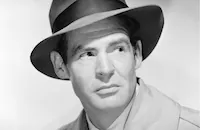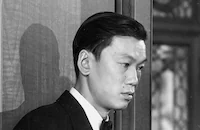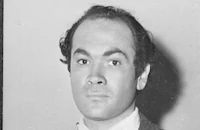Behind the Rising Sun

Brief Synopsis
Cast & Crew
Edward Dmytryk
Margo
Tom Neal
J. Carroll Naish
Robert Ryan
Gloria Holden
Film Details
Technical Specs

Synopsis
In Tokyo in 1943, Reo Seki receives the ashes of his dead soon Taro. Seated at the altar on which the ashes rest, Reo pens an entry to Taro in his diary, accepting blame for the tragedy which has befallen the Seki family and Japan. Reo's story begins in 1936, when the stirring of rabid nationalism causes Japanese rebels to slaughter Chinese on the streets of Tokyo. Soon after, Taro returns home from the United States, having just graduated from college. Brimming with American idealism, Taro decides to apply for a job as an engineer at the Tokyo-based O'Hara Engineering. Taro's father, Reo, an influential publisher and member of Japan's elite, opposes his son's decision. Reo maintains a naïve faith in the judgment of the emperor and confides in Taro his grandiose vision that Japan will soon rule the world. At a hotel bar one evening, Taro meets with Clancy O'Hara, the owner of the engineering firm, to discuss his employment. Also at the bar are O'Hara's longtime sweetheart Sara, a foreign correspondent enroute to Pekin, and Max and Boris, two spies. After Sara tries and fails to convince O'Hara to propose to her, he and the others leave to play poker at a geisha house. There they are joined by Lefty, the boisterous American coach of a baseball team. After being hired by O'Hara, Taro begins to date the firm's receptionist, Tama, who admires the Americans because they aided her tiny village after a devastating earthquake and sent her through school. Seventeen months later, Taro has fallen in love with Tama, but Reo withholds his permission to marry because Tama is a member of the lower class. Soon after, Japan goes to war against China, and Taro is drafted to work as an engineer there. One year later, Sara meets Taro in Pekin and finds him cold-bloodedly watching the Japanese troops torture helpless Chinese children. Meanwhile, in Japan, Tama is accepted by Taro's family when she shares his letters with them. At the urging of Taro's grandmother, Reo consents to the marriage on the condition that Tama agree to be adopted by an upper class family. When Taro returns home, he learns that his father has been appointed the new Minister of Propaganda. At the engineering office one day, O'Hara is toasting the engagement of Taro and Tama when Sara enters and accuses Taro of murdering little children in China. Insisting that his honor has been insulted, Taro demands satisfaction, and to settle the disagreement, a boxing match is arranged between Lefty and a Japanese wrestler. After Lefty soundly defeats the wrestler, Reo sends for O'Hara to apologize for Taro's behavior. Citing Taro as an example of Japan's thirst for savagery, Reo warns O'Hara that war between Japan and America is imminent and advises him to return home. Later, Tama and Taro travel to the countryside to meet her parents, and Tama learns that her little sister has been sold into slavery in Tokyo. As Taro praises the girl's sale as a "noble sacrifice," word comes of the bombing of Pearl Harbor. Taro hurries back to Tokyo and rejoins his air corps regiment, while Tama begins a futile search for her sister. Soon after, Sara, O'Hara and Lefty are arrested as spies, and Tama is apprehended and tortured to testify against them. Meanwhile, Taro is awarded his own squadron and returns to Tokyo to denounce his former friends as spies. When Reo reproaches his son's actions, Taro curses him and leaves. Lefty is killed during his interrogation, and as Tama, Sara and O'Hara await their execution, the sound of air raid sirens pierce the night, and Allied planes appear on the horizon to drop their bombs over Tokyo. The prisoners are removed from their cells and sheperded to the prison yard. There, a car pulls up, and the driver gestures for them to climb in. After speeding away, the driver tells them that Reo has arranged for their safe passage to Sweden. Declaring that her place is in Japan, Tama steps out of the vehicle and remains behind. As she looks skyward, Taro's plane is hit and crashes in flames. Upon completing the entry in his diary, Reo looks at his son's ashes and repudiates the emperor. He then commits hara-kiri in hopes that his death will signal the destruction of the old order and bring redemption to the Japanese people.

Director

Edward Dmytryk
Cast

Margo

Tom Neal

J. Carroll Naish

Robert Ryan

Gloria Holden

Don Douglas

George Givot
Adeline Dewalt Reynolds
Leonard Strong
Iris Wong
Wolfgang Zilzer
Shirley Lew

Benson Fong

Richard Loo
Luke Chan
Philip Ahn
William Yip
Lee Tung Foo

Mike Mazurki
Paul Hilton
George Lee
Paul Fung
James Leong
Spencer Chan
Stanley Wong
Aen Ling Chow
Preston Lee
H. T. Tsiang
Eddie Lee
Wing Foo
Bruce Wong
Leon Lontoc
Mei Lee Goo
Allan Jung

Abner Biberman
Connie Leon

Nancy Gates
Fred Essler
Daisy Lee
Jessie Tai Sing
Barbara Jean Wong
Beal Wong
Charles Lung
Mrs. Chan Pon
Don Pon
Robert Katcher
Crew
C. Bakaleinikoff
Alice Barlow
Mel Berns
Claude Carpenter
Albert S. D'agostino
Edward Dmytryk
Al Herman
Emmet Lavery
Roy Meadows
Russell Metty
Joseph Noriega
Ruby Rosenberg
Darrell Silvera
Edward Stevenson
James G. Stewart
Vernon L. Walker
Roy Webb
James R. Young

Film Details
Technical Specs

Articles
Behind the Rising Sun
It's the story of a Japanese newspaper publisher (J. Carrol Naish) who forces his Cornell-educated son (Tom Neal) to join the Japanese army against his will. Both men are hardened and changed by the war, and the film depicts grisly atrocities committed by the Japanese against Chinese women and children as well as Americans. Dmytryk later explained his and Lavery's approach to this picture: "We bought a book for its title - Behind the Rising Sun - not an unusual practice in Hollywood. Then we concocted a story based largely on incidents as they had been reported from the Orient before Pearl Harbor. For example: The slapping of American women, the dispersal of opium to Chinese to keep them docile, etc. On a not very original plot, we strung ten or twelve incidents calculated to increase the flow of patriotic juices. It worked." Seen today, of course, one must bear in mind the context in which the picture was made, and why it was made - to unite the public behind the war effort and to rally moviegoers to buy war bonds. At the time the film came out, after all, Allied victory was certainly not assured.
Behind the Rising Sun features a memorable fight sequence between an American boxer (Robert Ryan) and a Japanese judo wrestler (Mike Mazurki). This fight was based on an actual prewar incident in which the boxer won. Ryan had been a real-life boxing champion while at Dartmouth College and would play a washed-up boxer in one of his most famous movies, The Set-Up (1949), which is filled with top-notch boxing sequences. The ten-minute fight in Behind the Rising Sun is just as intense, with Variety describing it as "a rouser" and Time Magazine going so far as to declare it "as savage as anything in the history of screen roughhouse." Dmytryk was rightfully proud of the scene, calling it "a beautifully choreographed battle between two superior athletes. Even the pro-Axis Argentines cut the fight out of the film and ran it as a special short."
Ryan's character meets a tragic end in this picture, and in fact it was one of the first to establish his screen presence of outward strength and toughness mixed with inner suffering. This was the second of five films on which Ryan and Dmytryk would collaborate. Also in the cast is Margo, best remembered as the girl who suddenly ages when she leaves Shangri-La in Lost Horizon (1937).
Producer: Howard Hughes
Director: Edward Dmytryk
Screenplay: Emmet Lavery, James R. Young (novel)
Cinematography: Russell Metty
Film Editing: Joseph Noriega
Art Direction: Albert S. D'Agostino, Alfred Herman
Music: Roy Webb
Cast: Margo (Tama Shimamura), Tom Neal (Taro Seki), J. Carrol Naish (Reo Seki), Robert Ryan (Lefty O'Doyle), Gloria Holden (Sara Braden), Donald Douglas (Clancy O'Hara).
BW-89m. Closed captioning.
by Jeremy Arnold

Behind the Rising Sun
Quotes
Trivia
Notes
The working title of this film was The Mad Brood of Japan. The picture opens with the following prologue: "This is a true-to-life story of Japan. The characters are imaginary but the incidents are real. The episodes are based on actual facts, verified and authenticated." According to a Hollywood Reporter news item, James R. Young, the writer of the novel on which this film was based, worked for thirteen years prior to the bombing of Pearl Harbor as an International News Service correspondent in Japan. At one point during his tenure, Young was jailed by the Japanese for sixty-one days on the charge of knowing political secrets and writing critical stories about Japan. Another news item in Hollywood Reporter noted that Young was scheduled to deliver a series of lectures at the film's openings. Screenwriter Emmet Lavery and director Edward Dmytryk previously worked together on the 1943 RKO anti-Nazi film Hitler's Children (see below).














